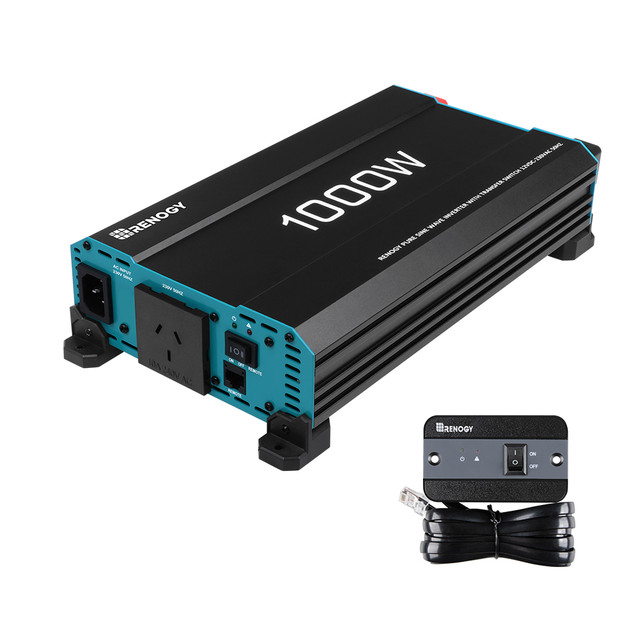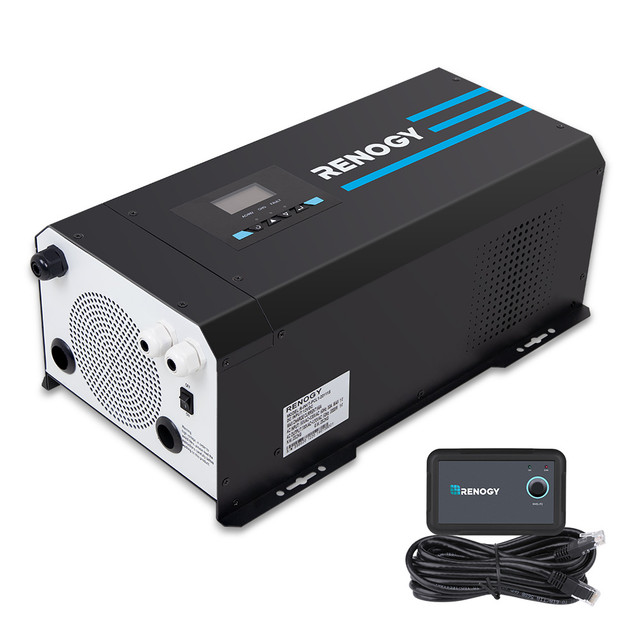Inverters
main product
Filter
6Items
Sort By:

Sort By:
Featured Items
Newest Items
Best Selling
A to Z
Z to A
By Review
Price: Ascending
Price: Descending
COMPARE INVERTERSS
 |
 |
 |
 |
 |
|
|---|---|---|---|---|---|
| Link | R-INVT-PUH1-301235-AU | R-INVT-PUH1-201235-AU | R-INVT-PUH1-101235-AU | R-INVT-PCL1-30123S-AU | R-INVT-PCL1-20123S-AU |
| Name | 3000W 12V to 240V Pure Sine Wave Inverter | 2000W 12V to 240V Pure Sine Wave Inverter | 1000W 12V to 240V Pure Sine Wave Inverter | 3000W 12V Pure Sine Wave Inverter Charger w/ LCD | 2000W 12V Pure Sine Wave Inverter Charger w/ LCD |
| Rated Output Power | 3000W | 2000W | 1000W | 3000W | 2000W |
| Surge Power | 6000W | 4000W | 2000W | 9000W | 6000W |
| Input Voltage | 12V DC | 12V DC | 12V DC | Inverter: 12V DC, Charger: 230V AC | Inverter: 12V DC, Charger: 230V AC |
| Output Voltage | 220-240V AC | 220-240V AC | 220-240V AC | 200~240VAC, 10V intervals | 200~240VAC, 10V intervals |
| Static Current | 1.5A | 1.3A | 1A | / | / |
| Output Frequency | 50HZ | 50HZ | 50HZ | 60HZ±0.3HZ | 50HZ±0.3HZ |
| Output Wave form | Pure Sine Wave | Pure Sine Wave | Pure Sine Wave | Pure Sine Wave | Pure Sine Wave |
| Low Voltage Shutdown | 10V DC | 10V DC | 10V DC | 10V DC±0.3V DC | 10V DC±0.3V DC |
| High Voltage Shutdown | 16.3V DC | 16.3V DC | 16.3V DC | 16.0V DC | 16.0V DC |
| Maximum Efficiency | 90% | 90% | 90% | 90% | 90% |
| Battery Types | GEL, AGM, SLA, FLD, CAL, LI, USER | GEL, AGM, SLA, FLD, CAL, LI, USER | GEL, AGM, SLA, FLD, CAL, LI, USER | GEL, AGM, SLA, FLD, CAL, LI, USER | GEL, AGM, SLA, FLD, CAL, LI, USER |
| Transfer Time | 50mS | 50mS | 50mS | 10mS | 10mS |
| Working Temperature | 0°C~40°C | 0°C~40°C | 0°C~40°C | 0°C~40°C | 0°C~40°C |
| Dimensions | 482*220*92 mm | 442*220*92 mm | 342*173*76 mm | 510*285*193 mm | 510*285*193 mm |
| Weight | 6.4Kg | 4.8Kg | 2.6kg | 28.8 Kg | 23.2 Kg |
| Frequently bought together | 2* 12V/24V/48V 200Ah Core Series Deep Cycle Lithium Iron Phosphate Battery | 1* 12V/24V/48V 200Ah Core Series Deep Cycle Lithium Iron Phosphate Battery | 1* 12V/24V/48V 100Ah Core Series Deep Cycle Lithium Iron Phosphate Battery | 2* 12V/24V/48V 200Ah Core Series Deep Cycle Lithium Iron Phosphate Battery | 1* 12V/24V/48V 200Ah Core Series Deep Cycle Lithium Iron Phosphate Battery |
Frequently Asked Questions
What is a power inverter and do I need it?
Power inverters convert the DC output collected from your solar panels into alternating current (AC), the standard used by all commercial appliances. Solar power inverters are the gateway between the photovoltaic system and the devices and appliances drawing energy from your solar panel system. You’ll typically need a power inverter for any solar panel larger than five watts. Despite the fact that solar inverters can power appliances on mobile vehicles like an RV, truck, motorhome, or boat, there are also power inverters for homes during an outage to keep household appliances operating. If you require emergency backup power for your house because of a power outage caused by storms, hurricanes, or harsh winter weather, a home inverter can keep your essential appliances functioning.
What is the difference between pure sine wave and modified sine wave inverters?
When shopping for an inverter, there are two main options to choose from: pure sine wave and modified sine wave inverters.
Pure Sine Wave Inverters:
Pure sine wave inverters are capable of producing smooth, quiet, and reliable electricity to operate appliances and electronics without any interference. Like its name suggests, pure sine wave inverters produce current in a pure sine wave shape. Renogy sells a range of pure sine wave inverters of varying capacities to fit your solar installation and energy needs. Renogy solar panel inverters also provide overload protection for both DC input and AC output to prevent damage to the components and the unit.
Modified Sine Wave Inverters:
In modified sine wave inverters, the polarity abruptly switches from positive to negative versus a true sine wave. When looking at the wave, it has a stair-step, square pattern, where the polarity is flipped back and forth. That choppy wave can negatively affect more delicate, sensitive equipment. If you have medical equipment you need to power, such as a CPAP machine, you won’t be able to use a modified sine wave inverter. Additionally, in many cases, you’ll hear a hum with devices attached to a modified sine wave inverter. However, with simple devices and appliances, modified sine wave inverters typically do the job.
What do I need a pure sine wave inverter to run?
As noted above, you need a pure sine wave inverter to run appliances with AC motors, such as microwaves and refrigerators; medical equipment, such as CPAP machines with humidifiers, sensitive electronics, laser printers, newer TV’s, and appliances with electronic timers or digital clocks. Your laptop may work with a modified sine wave inverter, although some claim that using one can shorten the lifespan of your laptop’s battery.
What is a hybrid inverter?
A hybrid inverter, also called a hybrid grid-tied inverter or a battery-based inverter, is a single piece of equipment that combines a solar inverter and a battery inverter. Inverter for solar panels convert the DC electricity that your solar panels generate into AC electricity that your home's appliances can use. Let's say you install a solar panel system with a standard solar panel inverter and then decide to add a battery system later. You will need a battery-specific inverter to convert the power from AC to DC for your battery to store and discharge. However, suppose you connect your solar panel system with a hybrid inverter. In that case, you don't need a separate battery inverter because the hybrid inverter may serve as an inverter for both solar-generated electricity and a solar battery. It's important to note that while hybrid inverters are designed to include storage, you may install hybrid inverters without batteries. In fact, many customers choose to add a hybrid inverter to their system before they add batteries in the future.






